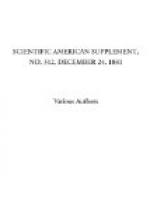Each drawer contains fifty tracings. They are two and a half inches deep, which is enough to hold several times as many, but this number is quite all that it is convenient to keep together. We would recommend for these shallower drawers.
Each drawing is marked in stencil in the lower right hand corner, and also with inverted plates in the upper left hand corner, with the letter and number of the drawer, and its own number in the drawer, as, for example, 3F—31; so that whichever way the sheet is put in the drawer, this appears at the front right hand corner. The drawings in each drawer are numbered separately, fifty being thus the highest number used.
For reference we depend on our indices. Each tracing, when completed, is entered under its letter in the numerical index, and is given the next consecutive number, and laid in its place.
From this index the title and the number are copied into other indices, under as many different headings as possible.
Thus all the drawings of any engine, or tool, or machine whatever, become assembled by their titles under the heading of such particular engine, or tool, or machine. So also the drawings of any particular part, of all sizes and styles, become assembled by their titles under the name of such piece. However numerous the drawings, and however great the variety of their subjects, the location of any one is, by this means, found as readily as a word in a dictionary. The stencil marks copy, of course, on the blue prints, and these when not in use are kept in the same manner as the tracings, except that only twenty-five are placed in one drawer.
We employ printed classified lists of the separate pieces constituting every steam engine, the manufacture of which is the sole business of these works, and on these, against the name of every piece, is given the drawer and number of the drawing on which it is represented. The office copies of these lists afford an additional mode of reference and a very convenient one, used in practice almost exclusively. The foreman sends for the prints by the stencil marks, and these are thus got directly without reference to any index. They are charged in the same way, and reference to the numerical index gives the title of any missing print.
We find the different sizes to be used quite unequal. The method of making a separate tracing of each piece, which we carry to a great extent, causes the smaller sizes to multiply quite rapidly. We are marking our patterns with the stencil of the drawing of the same piece; and also, gauges, templets, and jigs.
It is found best to permit the sheets to be put away by one person only, who also writes up the indices, which are kept in the fire proof.
We were ourselves surprised at the saving of room which this system has effected. Probably less than one-fourth the space is occupied that the same drawings would require if classified according to subjects.




